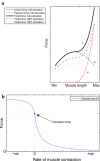Understanding and Overcoming the Sticking Point in Resistance Exercise
- PMID: 26758462
- PMCID: PMC4887540
- DOI: 10.1007/s40279-015-0460-2
Understanding and Overcoming the Sticking Point in Resistance Exercise
Abstract
In the context of resistance training the so-called "sticking point" is commonly understood as the position in a lift in which a disproportionately large increase in the difficulty to continue the lift is experienced. If the lift is taken to the point of momentary muscular failure, the sticking point is usually where the failure occurs. Hence the sticking point is associated with an increased chance of exercise form deterioration or breakdown. Understanding the mechanisms that lead to the occurrence of sticking points as well as different training strategies that can be used to overcome them is important to strength practitioners (trainees and coaches alike) and instrumental for the avoidance of injury and continued progress. In this article we survey and consolidate the body of existing research on the topic: we discuss different definitions of the sticking point adopted in the literature and propose a more precise definition, describe different muscular and biomechanical aspects that give rise to sticking points, and review the effectiveness of different training modalities used to address them.
Figures


Similar articles
-
The Sticking Point in the Bench Press, the Squat, and the Deadlift: Similarities and Differences, and Their Significance for Research and Practice.Sports Med. 2017 Apr;47(4):631-640. doi: 10.1007/s40279-016-0615-9. Sports Med. 2017. PMID: 27600146 Free PMC article.
-
The effects of ten weeks resistance training on sticking region in chest-press exercises.PLoS One. 2020 Jul 9;15(7):e0235555. doi: 10.1371/journal.pone.0235555. eCollection 2020. PLoS One. 2020. PMID: 32645111 Free PMC article.
-
Adding the Load Just Above Sticking Point Using Elastic Bands Optimizes Squat Performance, Perceived Effort Rate, and Cardiovascular Responses.J Sports Sci Med. 2020 Nov 19;19(4):735-744. eCollection 2020 Dec. J Sports Sci Med. 2020. PMID: 33239948 Free PMC article.
-
A systematic review of the biomechanical research methods used in strongman studies.Sports Biomech. 2020 Feb;19(1):90-119. doi: 10.1080/14763141.2019.1598480. Epub 2019 May 27. Sports Biomech. 2020. PMID: 31132028
-
Weightlifting Overhead Pressing Derivatives: A Review of the Literature.Sports Med. 2019 Jun;49(6):867-885. doi: 10.1007/s40279-019-01096-8. Sports Med. 2019. PMID: 30924081 Free PMC article. Review.
Cited by
-
Eccentric Muscle Actions Add Complexity to an Already Inconsistent Resistance Exercise Nomenclature.Sports Med Open. 2023 Dec 19;9(1):118. doi: 10.1186/s40798-023-00667-4. Sports Med Open. 2023. PMID: 38112984 Free PMC article.
-
Electromyographic comparison of the barbell deadlift using constant versus variable resistance in healthy, trained men.PLoS One. 2019 Jan 22;14(1):e0211021. doi: 10.1371/journal.pone.0211021. eCollection 2019. PLoS One. 2019. PMID: 30668589 Free PMC article. Clinical Trial.
-
Effects of Variable Resistance Training Within Complex Training on Neuromuscular Adaptations in Collegiate Basketball Players.J Hum Kinet. 2022 Nov 8;84:174-183. doi: 10.2478/hukin-2022-0094. eCollection 2022 Oct. J Hum Kinet. 2022. PMID: 36457466 Free PMC article.
-
The Acute Effects of Attaching Chains to the Barbell on Kinematics and Muscle Activation in Bench Press in Resistance-Trained Men.J Funct Morphol Kinesiol. 2022 May 4;7(2):39. doi: 10.3390/jfmk7020039. J Funct Morphol Kinesiol. 2022. PMID: 35645301 Free PMC article.
-
Effects of Variable-Resistance Training Versus Constant-Resistance Training on Maximum Strength: A Systematic Review and Meta-Analysis.Int J Environ Res Public Health. 2022 Jul 13;19(14):8559. doi: 10.3390/ijerph19148559. Int J Environ Res Public Health. 2022. PMID: 35886409 Free PMC article.
References
-
- Drinkwater EJ, Galna B, McKenna MJ, et al. Validation of an optical encoder during free weight resistance movements and analysis of bench press sticking point power during fatigue. J Strength Cond Res. 2007;21(2):510–517. - PubMed
-
- Duffey MJ, Challis JH. Fatigue effects on bar kinematics during the bench press. J Strength Cond Res. 2007;21(2):556–560. - PubMed
Publication types
MeSH terms
LinkOut - more resources
Full Text Sources
Other Literature Sources

